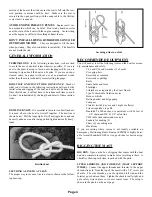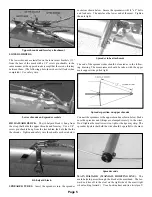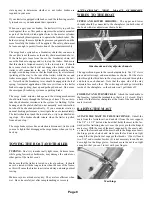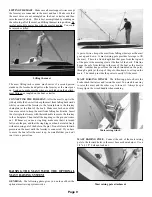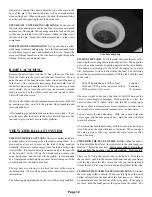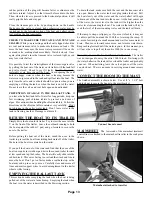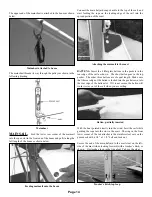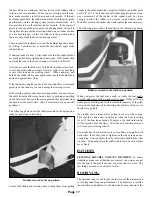
providing sideways stability. With the crew weight forward, the
nose is depressed. The deep V nose shape does not contribute
much to stability. When excess weight is at the front of the boat,
the less stable nose area is carrying more of the weight of the boat
and crew, the boat becomes far more easily tipped. Keep weight
off of the forward V berth when under way, and avoid storing
heavy items under the V berth. Crew members on the foredeck or
cabin top are far more likely to get bounced out of the boat than
those in the cockpit or inside the cabin. Anyone on the cabin top
will have a natural tendency to grab the mast or mast support
wires if the boat tips. That puts a heavy load high on the mast and
tends to lever the boat over. Keep the weight low. Obviously, it
is best to have the crew positioned so the boat sits or rides level
rather than leaning to one side or the other.
Do not have the sails up when the ballast tank is empty. They can
produce a very strong sideways force and capsize the boat.
If the waves are larger than one foot, they can induce a lot of
rolling motion and compromise stability. Keep the ballast tank
full in such conditions.
If you are operating where the chance of outside rescue is slim,
where conditions are rough, or where the water is cold and
uninviting, fill the ballast tank. You will go slower, but you will
be a lot safer. A full ballast tank gives greater safety.
NEVER SAIL OR POWER WITH THE BALLAST
TANK PARTIALLY FULL
(except for the few minutes that
it takes to drain the tank when you are under power). With the
water sloshing around in the tank, the center of gravity of the
water changes rapidly, which can make the boat relatively unsta-
ble. Fill the ballast tank full and make sure the vent and valves
are securely closed. Be extra cautious when the tank is filling or
draining. You can drain the tank by powering the boat at 7 miles
per hour. You will be able to see the water shooting out the valve
in the transom. The water tank will empty in about 3 to 4 minutes.
If the valve or vent plug is open, even slightly, the motion of the
boat can drain the ballast water from the tank or allow the boat to
fill with water. If either the vent plug or the filling valve is open,
ballast can be lost when the boat leans over. You might think that
the tank is full, and that the boat is self righting, but you may be
unpleasantly surprised by an unexpected capsize. If the transom
valve is left open, or partially open, the forward motion of the boat
can drain the tank. Drain the tank in the smoothest water you can
find. Avoid fast stops and starts, or turns, while the tank is drain-
ing. After you think the tank is empty, check the level with the dip
tube just to make sure.
NEVER POWER THE BOAT OVER 6 MILES PER
HOUR WITH THE SAILS UP.
The forward speed of the
boat can create enough wind to capsize the boat if the sails are up.
The result could be instant capsize. If the ballast tank is empty,
the boat will not be self righting.
NEVER POWER THE BOAT OVER 6 MILES PER
HOUR WITH THE DAGGERBOARD OR RUDDERS
DOWN.
If you hit something at high speed with the dagger-
board or rudders down, you will stop really fast, and may damage
the board or rudders . At high speed, the daggerboard and rudders
create lots of sideways lift and can cause the boat to be unstable.
This can roll the boat severely or possibly cause a capsize. Pull
the daggerboard all the way up into the boat and secure it well. It
is extremely important to check the control line frequently while
powering to be sure the board has not come loose and lowered
itself. This is particularly important when the boat is pounding
into waves and things tend to get jiggled loose. It is OK to leave
the daggerboard down for low speeds (under 6 mph), where it will
significantly enhance steering control.
BE EXTRA CAREFUL WHEN POWERING FAST.
Slow way down in waves or when powering with large crews.
Waves come in all shapes and sizes, and can yield some nasty sur-
prises. Wave induced problems, particularly with large crew
loads, or crew weight high on the boat, can cause an upset.
Watch the water ahead of you. Hitting heavy stuff in the water at
high speed can damage the boat or cause capsize. There is a lot
of junk out there that floats just at the surface, and it is often bare-
ly visible. Bumping into something at sailing speeds is one thing,
but at high speed, it can be nasty.
The boat will be less stable with the mast up than with the mast
down. The mast is light, but it is up there, and, like any other
weight aloft, reduces stability. When conditions are marginal,
(high winds, waves, lots of crew weight, etc.), lower the mast and
secure it to the pulpit and mast carrier.
DO NOT OPERATE THE BOAT WITH A LOT OF
WATER IN THE BILGE (OUTSIDE OF THE BAL-
LAST TANK)
.
It can slosh around and seriously degrade sta-
bility. Always keep your bilges dry. Check the bilge frequently.
There are a number of places where water can collect. Check
them all.
THE TOP OF THE DAGGERBOARD MUST NEVER
GO MORE THAN 57” BELOW THE LEVEL OF THE
DECK.
There is a line, with a knot and washer, that will keep
the board from going too far down. Do not change the position of
the knot, and make sure that it is in the same position if the line is
replaced.
DO NOT ALLOW ANY PART OF THE BOAT, TRAIL-
ER, MAST OR RIGGING TO COME IN CONTACT
WITH ANY SOURCE OF ELECTRICAL POWER.
If
your mast or any part of your boat or rigging comes in contact
with a power line, you could be killed or injured. Don’t sail your
boat into a power line. Don’t raise the mast into a power line.
Don’t move your boat, on its trailer, into a power line. Masts,
wires, or wet fiberglass are good conductors of electricity and can
carry current directly to you. Look up and make sure you will be
clear of sources of power before doing anything with your boat.
Don’t remove the warning decal from your mast. It may help you
remember to look and avoid a major calamity.
If you are caught in an electrical storm, don’t touch anything that
Page 2
Содержание 26 M
Страница 28: ...Page 28...




